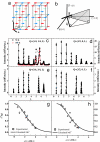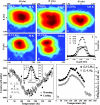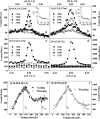Effect of antiferromagnetic spin correlations on lattice distortion and charge ordering in Pr0.5Ca1.5MnO4
- PMID: 17578911
- PMCID: PMC1894565
- DOI: 10.1073/pnas.0704303104
Effect of antiferromagnetic spin correlations on lattice distortion and charge ordering in Pr0.5Ca1.5MnO4
Abstract
We use neutron scattering to study the lattice and magnetic structure of the layered half-doped manganite Pr(0.5)Ca(1.5)MnO(4). On cooling from high temperature, the system first becomes charge-and orbital-ordered (CO/OO) near T(CO) = 300 K and then develops checkerboard-like antiferromagnetic (AF) order below T(N) = 130 K. At temperatures above T(N) but below T(CO) (T(N)<T<T(CO)), the appearance of short-range AF spin correlations suppresses the CO/OO-induced orthorhombic strain, contrasting with other half-doped manganites, where AF order has no observable effect on the lattice distortion. These results suggest that a strong spin-lattice coupling and the competition between AF exchange and CO/OO ordering ultimately determines the low-temperature properties of the system.
Conflict of interest statement
The authors declare no conflict of interest.
Figures





References
-
- Imada M, Fujimori A, Tokura Y. Rev Mod Phys. 1998;70:1039–1263.
-
- Tranquada JM, Sternlieb BJ, Axe JD, Nakamura Y, Uchida S. Nature. 1995;375:561–563.
-
- Fujita M, Goka G, Yamada K, Tranquada JM, Regnault LP. Phys Rev B. 2004;70:104517.
-
- Wollan EO, Koehler WC. Phys Rev. 1955;100:545–563.
-
- Goodenough JB. Phys Rev. 1955;100:564–573.
Publication types
LinkOut - more resources
Full Text Sources
Research Materials

